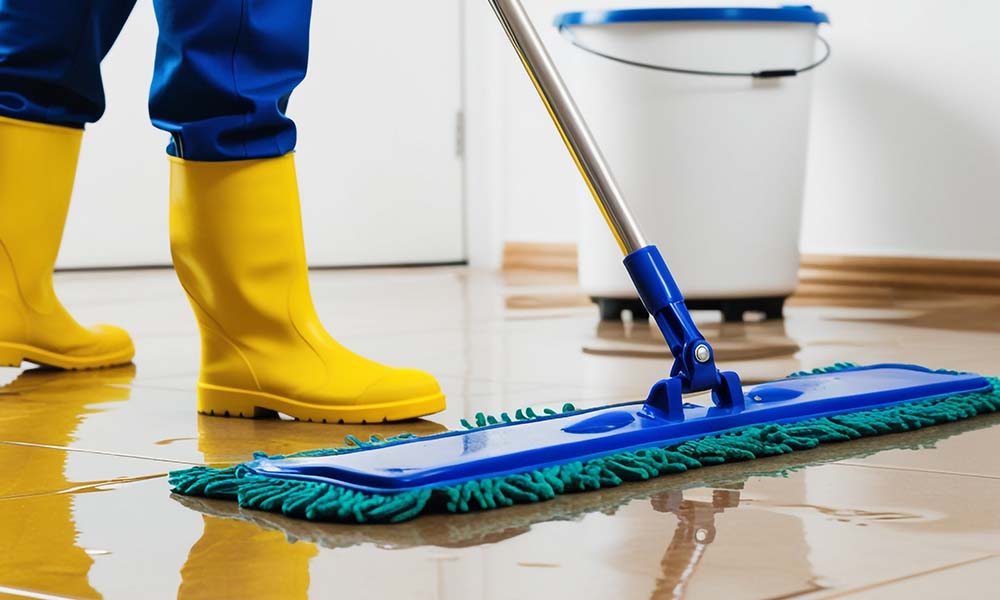Are you tired of looking at dull, dirty floors? Do you dream of floors that sparkle and shine? You’re not alone! Many homeowners struggle with keeping their floors clean and looking their best. But with the right information and techniques, floor care can be easy.
This guide will be your go-to resource for floor cleaning and maintenance, covering the best practices for different types of flooring—whether it’s hardwood, tile, laminate, or carpet. We’ll also explore the most effective cleaning techniques and tools to help you tackle dirt, grime, and stains, ensuring your floors stay beautiful for years to come.
Understanding Your Floor Type
The first step to effective floor cleaning is knowing the type of flooring you have, as each material requires a unique cleaning approach. Here’s a breakdown:
Hardwood Floors
- Sweeping/Vacuuming: Use a soft-bristled broom or vacuum to remove dust.
- Mopping: Use a damp mop with a mild hardwood cleaner. Avoid excessive water to prevent damage.
- Spot Cleaning: Blot spills quickly to avoid stains.
- Polishing: Apply hardwood polish every few months to maintain shine.
Tile Floors
- Sweeping/Vacuuming: Remove dust regularly to prevent buildup.
- Mopping: Use a mild tile cleaner. Avoid acidic cleaners that can damage grout.
- Grout Cleaning: Clean grout with a dedicated cleaner or baking soda paste.
- Sealing: Seal tile floors to protect them from stains.
Laminate Floors
- Sweeping/Vacuuming: Regularly remove dust with a soft broom or vacuum.
- Mopping: Use a damp mop with laminate-safe cleaner. Avoid too much water.
- Spot Cleaning: Clean spills immediately with a soft cloth.
- Avoid Harsh Chemicals: Harsh cleaners can damage the laminate finish.
Carpet
- Vacuuming: Regular vacuuming (at least weekly) is essential to remove dust and dirt.
- Spot Cleaning: Use carpet cleaner for spills and stains.
- Deep Cleaning: Consider professional carpet cleaning every 12–18 months to remove deep-seated dirt.
Choosing the Right Cleaning Products
When choosing floor cleaning products, it’s essential to select those that are appropriate for your floor type:
Natural Cleaners
- Vinegar: A natural disinfectant that works well on many surfaces.
- Baking Soda: Great for cleaning and deodorising floors.
- Essential Oils: Add pleasant fragrance and cleaning power to your floor-cleaning solutions.
Commercial Cleaners
Always choose a cleaner specifically designed for your floor type to avoid damage. Check product labels to ensure compatibility, or seek advice from a professional cleaning service.
Cleaning Tools: Your Arsenal for Sparkling Floors
Having the right tools is key to effective floor cleaning.
Essential tools include:
- Broom: For daily sweeping.
- Vacuum: For both carpets and hard floors.
- Mop: Use a microfiber mop for most floor types, or consider using a steam mop for a deep clean.
- Bucket: For holding your cleaning solution.
- Squeegee: To remove excess water after mopping.
- Microfiber Cloths: Perfect for drying and polishing.
Step-by-Step Cleaning Guide for Different Floor Types
Hardwood Floors
- Sweep/Vacuum: Remove dust and debris.
- Damp Mop: Use a hardwood-safe cleaner and wring out excess water.
- Dry the Floor: Use a dry cloth or squeegee to remove moisture.
- Polish (Optional): Apply polish every few months to maintain shine.
Tile Floors
- Sweep/Vacuum: Remove dust.
- Mop: Clean with a mild tile cleaner.
- Grout Cleaning: Scrub grout with cleaner or baking soda.
- Dry: Use a dry cloth or squeegee to remove water.
Laminate Floors
- Sweep/Vacuum: Remove dust.
- Damp Mop: Use laminate-friendly cleaner and minimal water.
- Dry the Floor: Remove excess moisture with a cloth.
Carpet
- Vacuum: Regularly vacuum to remove dust.
- Spot Clean: Tackle spills immediately with a carpet cleaner.
- Deep Clean: Schedule professional cleaning every 12–18 months.
Maintaining Your Floors: Long-Term Tips
- Regular Cleaning: Sweep or vacuum floors regularly to prevent dirt buildup.
- Use Doormats: Place them at entryways to minimise dirt being tracked in.
- Avoid Scratches: Use furniture pads to prevent scratches on hardwood or laminate.
- Clean Spills Immediately: Prevent stains by cleaning up spills right away.
- Professional Cleaning: Consider professional cleaning for deep, thorough results.
Final Thoughts
By following these floor cleaning techniques, you’ll be able to keep your floors in pristine condition. Regular cleaning and proper maintenance not only preserve your floors’ appearance but also extend their lifespan. With a little effort and the right approach, you can enjoy beautiful, sparkling floors for years to come.
For more tips or to schedule a deep cleaning, explore our floor cleaning services.For professional cleaning services, contact Perth Express Cleaning and ensure your floors are always looking their best!
Frequently Asked Questions
How often should I clean my floors?
It depends on the flooring and traffic. Weekly cleaning is a good rule of thumb for most floor types.
What natural floor cleaners can I use?
Vinegar, baking soda, and essential oils are great natural cleaners that are eco-friendly and safe.
How do I remove tough stains from floors?
Use a stain remover designed for your floor type, or natural solutions like a baking soda paste for tougher stains.
How can I prevent scratches on my hardwood floors?
Use furniture pads and avoid dragging heavy furniture across the floor.
How often should carpets be professionally cleaned?
Every 12–18 months is ideal for a deep clean.


 1300 194 658
1300 194 658 info@perthexpresscleaning.com.au
info@perthexpresscleaning.com.au